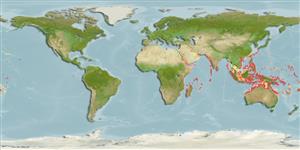Preferred temperature (Ref.
123201): 25.8 - 29.3, mean 28.4 °C (based on 2436 cells).
Phylogenetic diversity index (Ref.
82804): PD
50 = 0.5000 [Uniqueness, from 0.5 = low to 2.0 = high].
Bayesian length-weight: a=0.00692 (0.00284 - 0.01683), b=3.10 (2.92 - 3.28), in cm total length, based on LWR estimates for this Genus-body shape (Ref.
93245).
Trophic level (Ref.
69278): 3.1 ±0.3 se; based on size and trophs of closest relatives
Widerstandsfähigkeit (Ref.
120179): hoch, Verdopplung der Population dauert weniger als 15 Monate. (Preliminary K or Fecundity.).
Fishing Vulnerability (Ref.
59153): Low vulnerability (10 of 100).
🛈
Nutrients (Ref.
124155): Calcium = 397 [161, 1,149] mg/100g; Iron = 1.54 [0.65, 3.48] mg/100g; Protein = 17.6 [15.5, 19.4] %; Omega3 = 0.11 [0.04, 0.30] g/100g; Selenium = 35.5 [10.5, 105.1] μg/100g; VitaminA = 122 [24, 585] μg/100g; Zinc = 4.26 [2.34, 7.09] mg/100g (wet weight);
